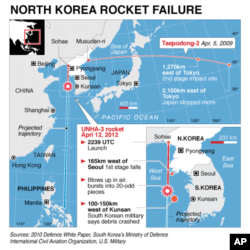The U.S. military is analyzing North Korea’s failed missile launch. The Pentagon says it does not yet know why the missile broke apart in what U.S. officials say was the second phase of Friday's launch, spilling debris into the sea off the coast of the Korean Peninsula. The failed launch attempt, however, has already provided a wealth of new information on Pyongyang’s missile program.
For North Korea, this was supposed to be a show of pride. Pyongyang had invited foreign journalists for a rare glimpse of its secretive program.
Breaking up in just seconds, the failure was quick and obvious -- and so has been the payoff for analysts like Tim Brown of globalsecurity.org. Compared to the satellite imagery he normally analyzes, journalists’ photos from up close are a bonanza for him.
“For one thing, to be able to see this from a couple of hundred yards away is just breathtaking. We’re able to see the launch tower and the rocket in excruciating detail that leaves nothing to the imagination,” Brown said.
North Korea had hoped to showcase the missile as a major technological advance.
Brown says what the launch really showed was how primitive its program is.
“For example the gantry on the tower, which is the crane that they use to move everything around, looked sort of military or missile related. And to take a look at it now, up close, it’s just a regular construction crane that you can see anywhere in the world,” Brown said.
The U.S. military watched the missile lift off and break into pieces over the sea off the Korean Peninsula in the second phase of the launch, and is now analyzing what happened.
The failure perhaps allays some worries for U.S. officials -- who were concerned that the missile might have a long enough range to reach key U.S. Pacific installations on Okinawa in Japan, or Guam.
But the Pentagon still considers the failed launch a serious matter and is calling it a provocative act.
Patrick Cronin, a defense analyst with the Center for a New American Security says the U.S. has reason to remain concerned.
“North Korea is repeating this cycle of missile tests, potentially nuclear tests and we say This is just the status quo, but it’s not the status quo because North Korea keeps improving its capabilities. These are very serious capabilities that they’re improving. By breaking the cycle it means we’ve got to be willing to do something more dramatic,” Cronin said.
With the missile launch behind, U.S. defense officials now have their eye on Pyongyang’s next move and what South Korean intelligence believes may be plans by the north to carry out a new underground nuclear test.







